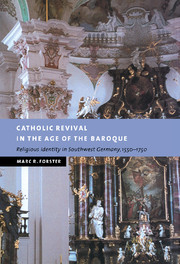Book contents
- Frontmatter
- Contents
- List of maps
- Acknowledgments
- List of abbreviations
- Introduction
- 1 The Counter-Reformation offensive, 1550–1650
- 2 The sacral landscape and pilgrimage piety
- 3 Religious practice
- 4 Clericalism in the villages
- 5 The communal church in German Catholicism
- 6 Reformers and intermediaries, 1650–1750
- Conclusion
- Bibliography
- Index
2 - The sacral landscape and pilgrimage piety
Published online by Cambridge University Press: 17 July 2009
- Frontmatter
- Contents
- List of maps
- Acknowledgments
- List of abbreviations
- Introduction
- 1 The Counter-Reformation offensive, 1550–1650
- 2 The sacral landscape and pilgrimage piety
- 3 Religious practice
- 4 Clericalism in the villages
- 5 The communal church in German Catholicism
- 6 Reformers and intermediaries, 1650–1750
- Conclusion
- Bibliography
- Index
Summary
It is possible to identify a number of fundamental characteristics of popular religious practice in the Catholic villages and towns of Southwest Germany. Throughout the early modern period, but particularly in the century after 1650, popular Catholicism centered around public and often dramatic practices, especially pilgrimage, processions, and the festivals of the liturgical year, many of which were associated with the immensely popular cult of the Virgin Mary. This dramatic religious style, which we tend to associate with Baroque Catholicism, was complemented by a commitment to regular daily and weekly church services which fed the popular appetite for the other central cult, that of the Eucharist.
Much of popular Catholicism remained communal and public. In the eighteenth century there was, however, a trend toward more individual and private religious devotion. Such devotions were part of pilgrimage piety, included in regular parish services, and could be found within confraternities. The prayers of the Rosary, most often practiced by women in small groups or individually, spread quickly and widely in this part of Germany and served as a kind of benchmark of more individualized devotional practices.
Despite the growing popularity of individual devotional practices, which were generally promoted by the clergy, popular Catholicism never succumbed to the other efforts by lay and clerical elites to regularize, systematize, and simplify religious practice.
- Type
- Chapter
- Information
- Catholic Revival in the Age of the BaroqueReligious Identity in Southwest Germany, 1550–1750, pp. 61 - 105Publisher: Cambridge University PressPrint publication year: 2001



